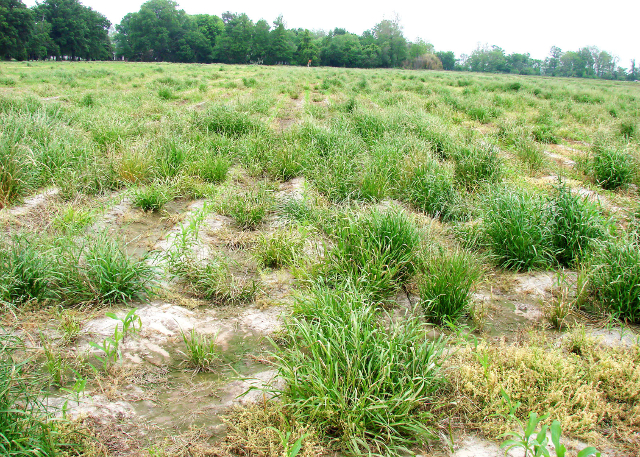Fall Herbicide Applications More Effectively Manage Resistant Italian Ryegrass

Glyphosate-resistant Italian ryegrass in a production corn field in Washington County, MS, early spring 2013. (Photo by MSU Delta Research and Extension Center/Jason Bond)
Italian ryegrass has shown resistance to five different herbicide modes of action in the U.S. Growers in the Midsouth are seeking new ways to control this threat to crop yields. Field studies show that a fall application of certain herbicides before weed emergence, leads to more successful crop planting and weed control in spring.
The article “Glyphosate-Resistant Italian Ryegrass (Lolium perenne ssp. multiflorum) Control with Fall-Applied Residual Herbicides,” in the current issue of Weed Technology presents results of field tests to determine the most effective timing of residual herbicides for control of glyphosate-resistant Italian ryegrass. Although grown for winter pasture and soil stabilization, Italian ryegrass has easily escaped cultivation, becoming problematic along roadsides and in cereal, vegetable, and grass crops.
“Glyphosate-resistant Italian ryegrass represents a serious threat to crop production systems in the Midsouth,” said Jason A. Bond, an associate researcher and extension professor at Mississippi State University and lead author of the study. “The presence of this weed also jeopardizes traditional glyphosate-based burndown programs. Management of glyphosate-resistant Italian ryegrass requires a multifaceted approach. Herbicide options are limited and Italian ryegrass has a history of rapidly developing resistance to multiple herbicide chemistries.”
If glyphosate-resistant Italian ryegrass is not controlled when fields are burned down, significant plant residue will be present at planting, competing with crop seedlings and hindering herbicide programs. The current study found that an effective management program for glyphosate-resistant Italian ryegrass starts with the application of herbicide prior to emergence, between mid-October and mid-November. Residual herbicides, such as S-metolachlor, trifluralin, and clomazone, can provide control until spring, depending on fall and winter rainfall.
What crops are to be planted in the spring must be considered when selecting a fall residual herbicide. Only S-metolachlor herbicides can be safely used in a field where corn will be planted, and only clomazone is appropriate for rice crops. S-metolachlor and trifluralin herbicides can be used prior to planting cotton or soybean crops.
Full text of the article, “Glyphosate-Resistant Italian Ryegrass (Lolium perenne ssp. multiflorum) Control with Fall-Applied Residual Herbicides,” Weed Technology, Vol. 28, No. 2, April–June 2014, is now available at www.wssajournals.org.






